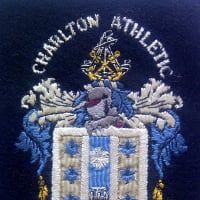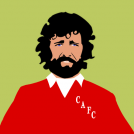The Third Oldest Known Charlton Home Programme and the Valley in 1919 as seen by away reports

We lost this game 1 - 2 in front of nearly 4,000 fans.
Charlton turned professional a few months later, a controversial decision opposed by many fans.
Who knows, if we had won and gone of a good run we might have stayed amateur and become a Dulwich Hamlet or Bromley rather than the football league side we would be by 1921.

Comments
-
The museum owns the oldest known home programme, for the 8 - 0 thrashing of our real local rivals, Ordnance FC on Christmas Day 1919 and a trustee owns the home Grays programme from December 1919 (4 - 2 win), both of which are mentioned in the notes in the Oxford programme.

13 -
Here's a local paper report of the game taken from an upcoming book on Charlton's pre-league history 1905 - 1921.
Club members and supporters will be interested to know that Capt. I H Benn, C.B., D.S.O., M.P., the club President, having returned from Canada, signified his intention to attend if at all possible, this being his first visit to the new enclosure. Team meet on ground 1.30 sharp; kick-off, 2.15 prompt. Half-an-hour extra must be played if the game in a draw.
There was a crowd of nearly 4,000 on the Charlton ground last Saturday, when Oxford City were entertained in the first round of the English Amateur Cup. The result was a win for Oxford by 2 goals to 1. It was a highly interesting and enjoyable game throughout. Oxford scored first, H Hartley doing the needful, but A. Sheppard quickly equalised. Then the interval arrived. Upon resumption, play continued very even and there was little to choose between the teams. A T Jakeman netted a second for Oxford. and although the Charlton forwards attacked with great energy and forced many corners, they were unable to draw level.
After the match last Saturday, the home team and officials adjourned to the club headquarters, to take tea. Mr. T. Kirkup, of the L.F.A. and Mr. E. Eden, of the L.L., were the guests, and, after the meal, made short speeches, congratulating the players on the splendid performance and saying that the defeat in no way reflected the club record, rather did it enhance the already high respect which was held the club in football circles, and they also tendered very valuable advice.
4 -
Charlton should never have played our number 9 that day. He wasn’t ready.2
-
A very long report of the Oxford local paper gave their reporters views on the Charlton area and ground.
"Reference has been made to the remarkable remarkably bare conditions of the Charlton ground, and some description of the playing pitch and its surroundings is necessary. The approach to it from the town was truly rustic, the roadway resembling nothing so much as a strip of muddy field littered with old cans and other debris of the ash heap type, and it led steeply down to the bottom of what was once a chalk quarry. On the other hand cliffs rose to a considerable height, and in the space between them the Charlton club are laying out the ground. It is their ambition to make their ground and its appointments “the envy of many amateur clubs”, and one would say unhesitatingly that this site and its surroundings lend themselves admirably to the fulfilment of that aim. There is immense space for the accommodation of spectators on the sloping cliffs, and it was this fact which made the attendance of over 3,000 seem comparatively scanty. The Charlton club has already done wonders in clearing and levelling the actual playing pitch and fencing in the ground, but it was the City’s luck to pay their visit while all this work of preparation is still in its infancy. Of covered shelter for spectators there was absolutely none, the enclosure containing but a single row of forms behind the ropes, while the dressing room for the teams was a very ordinary little wooden hut.Sporting Opponents
It was, however, the appearance of the actual playing piece that most astonished the Oxford folks so used as they are too good turf and plenty of grass. It was just a stretch of bare ground with little patches of grass here and there, and, while it had been cleared of brick-bats and big stones it was still what one would call rough and gravelly. Certainly, it was a ground on which a heavy fall might have a very painful consequence, but it was the fact that the ball was bound to the unusually lively made the Oxford people a little apprehensive as to the outcome of the game. Charlton are quite a local team of young working men, but they have been doing very well this season in the London Senior and Kent Leagues. By force of circumstances they are compelled to play against professionals in a professionals’ competition, but at heart the club is purely amateur, and in Saturday’s game, exciting though the situation often was, the players were always thorough sportsman."
5 -
I notice Oxford City numbered 12-22. Was it the norm for away teams to wear 12-22? Or didn't they wear any numbers at all really?0
-
Worth noting how the players are numbered.
1 to 22 but players didn't wear numbers on their shirts then0 -
The Oxford Centre Half that day was Kenneth Hunt, a two-time Olympian and gold medal winner. He won the football Gold in the 1908 Olympics in London where he played in three games (12-1 v Sweden, 4-0 v Netherlands and 2-0 v Denmark in the final) each of which had an English referee and two English linesmen.
He also played in the 1920 Olympics, GB losing in the first round to Norway, 3-1. In what was clearly an unfair act of outrageous gamesmanship, the organising committee saw fit to appoint only one Englishman among the three officials. Disgrace.
Hunt went on to be a teacher and could count Murray Walker as one of his pupils.4 -
Hunt was on the team sheet but didn't playChizz said:The Oxford Centre Half that day was Kenneth Hunt, a two-time Olympian and gold medal winner. He won the football Gold in the 1908 Olympics in London where he played in three games (12-1 v Sweden, 4-0 v Netherlands and 2-0 v Denmark in the final) each of which had an English referee and two English linesmen.
He also played in the 1920 Olympics, GB losing in the first round to Norway, 3-1. In what was clearly an unfair act of outrageous gamesmanship, the organising committee saw fit to appoint only one Englishman among the three officials. Disgrace.
Hunt went on to be a teacher and could count Murray Walker as one of his pupils.0 -
Our posts crossed.thai malaysia addick said:I notice Oxford City numbered 12-22. Was it the norm for away teams to wear 12-22? Or didn't they wear any numbers at all really?
I don't believe they wore numbers at all.1 -
I bet the goalie was a jolly, nice blokeHenry Irving said:Huge thanks to Oxford City historian Chris Byrne who has sent us a copy of this 1920 FA Amateur Cup game at what wasn't even being described as the Valley at the time, just the ground "adjoining Charlton Lane and Church Lane."
We lost this game 1 - 2 in front of nearly 4,000 fans.
Charlton turned professional a few months later, a controversial decision opposed by many fans.
Who knows, if we had won and gone of a good run we might have stayed amateur and become a Dulwich Hamlet or Bromley rather than the football league side we would be by 1921. 1
1 -
Sponsored links:
-
Curbs was named after the full back1
-
Was this the No 11’s first game back after serving his Christmas suspension? 😉0
-
Yes, shirt numbers didn't come in until just before WW2 I think. What's interesting is that the Charlton numbers seem to agree with the old classic system 2= right back, 7= right wing, 5 = centre half etc. Looks like we played a deep lying centre forward, years before the Hungarians.Henry Irving said:Worth noting how the players are numbered.
1 to 22 but players didn't wear numbers on their shirts then0 -
What's the blob in the middle of the Oxford City programme to the left of J.W.Lucas. It looks like three people jumping on top of each other. Or is it the sun and a tree? Just curious.0
-
It's a footballthai malaysia addick said:What's the blob in the middle of the Oxford City programme to the left of J.W.Lucas. It looks like three people jumping on top of each other. Or is it the sun and a tree? Just curious.2 -
this is an interesting history of shirt numbering .. Squad number (association football) - Wikipedia .. CAFC was one of the first to use the present system of squad numbers .. how 'hip' are we lolBig William said:
Yes, shirt numbers didn't come in until just before WW2 I think. What's interesting is that the Charlton numbers seem to agree with the old classic system 2= right back, 7= right wing, 5 = centre half etc. Looks like we played a deep lying centre forward, years before the Hungarians.Henry Irving said:Worth noting how the players are numbered.
1 to 22 but players didn't wear numbers on their shirts then0 -
By 'eck, that W T Neale was one hell of a linesman.Henry Irving said:Huge thanks to Oxford City historian Chris Byrne who has sent us a copy of this 1920 FA Amateur Cup game at what wasn't even being described as the Valley at the time, just the ground "adjoining Charlton Lane and Church Lane."
We lost this game 1 - 2 in front of nearly 4,000 fans.
Charlton turned professional a few months later, a controversial decision opposed by many fans.
Who knows, if we had won and gone of a good run we might have stayed amateur and become a Dulwich Hamlet or Bromley rather than the football league side we would be by 1921. 0
0 -
.0
-
.1
-
LOL, We went alphabetical and ended up with Sweaty Balmer wearing number one which was quite something for a centre back. Wonder if anyone noticed before we sent them to the League?this is an interesting history of shirt numbering .. Squad number (association football) - Wikipedia .. CAFC was one of the first to use the present system of squad numbers .. how 'hip' are we lol
0 -
Sponsored links:
-
And Jimmy Seed after the centre half.Henry Irving said:Curbs was named after the full back1 -
The first time shirt numbers were worn, was in the 1933 FA Cup final, between Everton & Man City. Everton Wearing 1-11, City 12-22.Big William said:
Yes, shirt numbers didn't come in until just before WW2 I think. What's interesting is that the Charlton numbers seem to agree with the old classic system 2= right back, 7= right wing, 5 = centre half etc. Looks like we played a deep lying centre forward, years before the Hungarians.Henry Irving said:Worth noting how the players are numbered.
1 to 22 but players didn't wear numbers on their shirts then
I remember this from owning the British MovieTone News Cup Finals VHS, of which we were featured in 3 (League War Cup vs Arsenal, then Derby & Burnley).0 -
No, that was Jimi HendrixStig said:
And Jimmy Seed after the centre half.Henry Irving said:Curbs was named after the full back1 -

0








